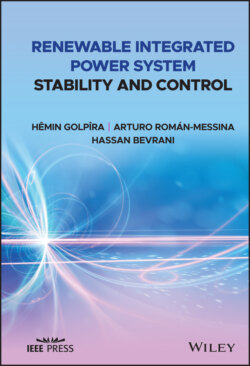Читать книгу Renewable Integrated Power System Stability and Control - Hassan Bevrani - Страница 19
1.2.2 Voltage Control
ОглавлениеSince 1990s, supplementary control of generator excitation systems, static var compensator (SVC), and high voltage direct current (HVDC) converters is increasingly being used to solve power system oscillation problems [7]. There has also been a general interest in the application of power electronics‐based controllers known as flexible alternating current transmission system (FACTS) controllers for the damping of system oscillations [79]. Following several power system collapses worldwide [80–82], in 1990s, voltage stability has attracted more research interests.
Recently, following the development of PMUs, communication channels, and digital processing, wide‐area power system stabilization and control have become areas of interest [83, 84]. A typical generic of different voltage control levels is discussed in [85]. Optimal voltage control has long been successfully implemented in power systems, including the three‐level hierarchical automatic voltage control in Europe [86–88], and the adaptive zone division method in China [89].
A supervisory voltage control strategy for large‐scale solar photovoltaic (PV) integration in power network is proposed in [90, 91] to enhance the voltage stability. A survey of methods, mostly based on PMU data, for long‐term voltage instability detection is given in [92]. In [93], a two‐stage distributed voltage control scheme is proposed. The first stage is the local control of each DG based on sensitivity analysis, and the second stage acquires reactive power support from other DG units. In [94], a consensus‐based cooperative control is proposed to regulate voltage by coordinating electric cars and active power curtailment of PVs. In [95], a distributed voltage stability assessment considering DG units is developed based on distributed continuation power flow. Coordinated voltage control is a technique which provides voltage control by means of adjusting, sequencing, and timing various kinds of controllers within a system. Some relevant works are reported in [96–98].
As mentioned above, several PMU‐based voltage control methodologies have been reported worldwide; however, mostly presented a voltage recovery approach in an off‐normal or emergency condition. Among existing three hierarchical levels of voltage control (primary, secondary, and tertiary controls), only few works are mainly focused on optimal supervisory on secondary voltage control, which is required to coordinate adjustment of the set‐points of the existing voltage controllers. In this regard, the online adaptive tuning of available voltage control systems in a power grid with high integration of DGs/RESs is not well addressed. Furthermore, the overlap between voltage dynamics and frequency/active power as well as rotor angle dynamics in a modern power grid has not been highlighted in the published reports.
